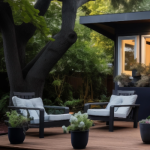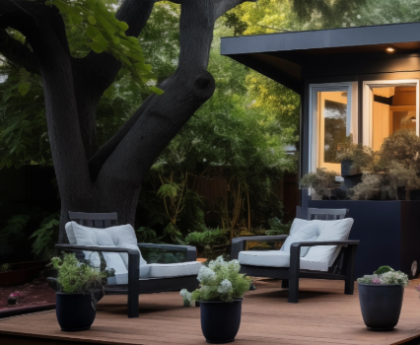
Spring Home Design
THERE’S MORE MATH wrapped up in the concept of “multigenerational living” than you might expect — even before you get to the “multi” part.
Let’s start with a quick statistic: If you’re not living with two or more other generations (as an estimated 1 in 4 Americans now does), you likely know someone who is or has or might. And even if you don’t have a multigen-er in your own social circle, all sorts of high-profile families, real and imagined, have presented here’s-how-this-could-look possibilities: the Obamas in the White House. The Waltons in the Blue Ridge Mountains. Every single grandparent of golden boy Charlie Bucket smooshed into a rectangle with the surface area of a Wonka Bar.
Along with the space-saving practicality of that last co-sleeping situation, the benefits of our multigenerational mathverse are scientifically proven and practically infinite: One interconnected triangle of generations sharing one home can deliver financial, emotional, cultural and environmental rewards. Trusted caregiving for any cohabitant? Simplified. Family bonds and interactions, intentional and spontaneous? Unmatchable.
Here’s how all of that adds up in three Seattle-area homes designed specifically, thoughtfully and spectacularly for three generations each. (That’s 22 people, people!)
KENTA NAKAMURA AND his partner are a little busy. They are both doctors — one a physician and the other a scientist — and they are parents to two young (and also busy) children.
Those worlds constantly intersect and influence each other — up to and including where they decided to live when they moved here from Boston.
One factor: Because he is on call so often and in so many emergency situations, Kenta needs to live within 20 minutes of the hospitals where he works. But when it comes to the family factor, life for the Nakamuras centers on the three generations that share a home that is distinctly home.
“There’s this sense that when we go down onto I-90 [to Mercer Island], we really feel like we’re leaving work,” Kenta says. “And I think for us, it was very important to be able to protect our time with our family.”
Kenta and his partner both grew up living with their grandparents, so after his father’s death, Kenta says, “I felt very strongly that I wanted to also include my mother in whatever plans we were going to have. We were really looking for a home to raise our family, and a home that would be comfortable for my mother.”
Mercer Island: prepackaged perfection. The 1986 multilevel Mercer Island home the Nakamuras chose: not quite.
They never expected anything turnkey, but even the pros at Plum Projects were bowled over by this house’s commitment to chopped-up wackiness.
“I don’t think anybody, when we first walked in, thought, ‘Oh, we’re going to transform it in this way,’ “ says principal Drew Daly. “It was much more of, ‘This house is insane. There is not a room with four 90-degree angles and corners.’ … I couldn’t even figure out how we were going to draw them.” (The acute challenges of the wonky angles made measuring room by room nearly impossible, Daly says, so lead designer Greg Lewis calculated the layout through the ceiling and roof system.)
The deeply collaborative remodeling process, you might imagine, took a minute, but the Nakamuras’ home ultimately transformed into a place that works for everyone individually, and for the whole family together. The entire interior is new, with an emphasis on Japanese design elements, modern minimalism, craftsmanship — and one special, central space with a mathematical name and a solid force at its core: The Cube.
Surrounded by sliding slatted wood screens, The Cube rises between the main-floor living area, dining area and kitchen to form a gorgeously useful pantry/office area.
“It originally was a library,” Kenta says. “But we said, ‘We like to cook, and we are always running out of storage. And Japanese cooking requires a lot of pantry goods. Where would we be able to put a pantry?’ And so that also evolved into, ‘Where would we be able to sit down and have the kids work on some homework, or where can we drop the mail?’ And so that space started with function. I think that’s probably the most Japanese part of the home: It is so functional that we don’t compromise function simply for aesthetics.”
Kenta’s favorite area of the form/function equation, though, is considerably less visible: a cleverly hidden appliance garage in a corner of the gleaming kitchen cabinetry. It not only puts otherwise-wasted space to beautiful use; it also holds something especially meaningful.
“In Japanese cooking, we use a lot of thinly sliced meats,” says Kenta. “And as far back as residency, I’ve always had a meat cutter so that I could thinly cut my own meat for sukiyaki, shabu-shabu, things like that. And I really wanted that to have a place. Those are the elements that feel very Japanese to me, because when I go back to my relatives’ homes, they don’t have the luxury of the space that we have. And so they’re built to an economy that is just incredible function-wise. And I love how that has translated to our home.”
Throughout the Nakamuras’ home, stunning spaces function on their own and with a vital sense of connection — floor to floor (thanks, new centralized staircases!) and generation to generation.
Starting from the top (as one does): The upstairs loft space is used as an office to take advantage of the views. Kenta’s mother has a private (but not isolated) suite near the front entrance on the main level, so she has no stairs to navigate en route to the hub of the home. “I’d always wanted her to feel like she had her own private space, that she wasn’t completely having to deal with the kids 24/7, that when it was time for her to be able to relax, she could be physically removed from the chaos that often surrounds our kids,” Kenta says. The center of that happy-kids chaos lives downstairs, with one bedroom for each child, a media space and plenty of room to play.
Everything, and everyone, this busy household needs is right here when they need it. Which is often, since family is the heart of the Nakamura home.
“We would not have been able to manage two kids, two busy careers without [my mother’s] help. We are really dependent and appreciative of her help,” Kenta says. “It was not clear that this was possible from the beginning, but it’s working as we had hoped.”
CHRISTIE KALOPER JONES calls her own extended family The 12-Pack. She and her husband, Tom, (2) have two grown children (+2) who, with their partners (+2), each have three kids (+6). (We love it when math adds up.)
Everyone has multiple, meaningful roles, plus a nickname or two — Christie is Bubbie or Baba, “professional grandmother”; Tom (“Papau”) is an ophthalmologist and “cottage retreat creator”; daughter Brooke Ann Jones O’Brien is “family coordinator and facilitator”; son Tommy is also an ophthalmologist, in addition to “Hood Canal enthusiast”; and the six-pack of grandkids ranges from age 3 (Adeline, “sand-castle builder, swim-buddy”) to 12-year-old “cousin-caretaker” Kiki.
There’s even a Jones family motto: “Do your best. Be a good family member. Have fun!”
It’s always fun to take a 12-pack of something on a road trip — especially when the destination is a waterfront family retreat where a charming pedestrian pathway weaves through integrated cottages like family and history weave through the very genesis of this special place, where everything is infused with the unifying essence of saltwater.
Christie and Tom, who have known each other since junior high, grew up in West Seattle and gravitated to Hood Canal in the 1960s for summers and holidays — just a quick ferry ride to Southworth and then blessed vacation.
“We’d always been about the water,” Christie says. “All of our friends would hang out together, and we’d swim. And it was just always a wonderful place.”
As the Joneses grew, so did their Hood Canal options: Christie’s family rented a vacation place at Pebble Shores. Her uncle bought a place of his own. Tom’s parents built a cabin in the ‘70s and a forever home in the ‘90s. A couple of his sisters bought homes here, too.
Tom’s older sister eventually bought their parents’ “big house” from the rest of the siblings.
“It had become a real footprint for the family,” Christie says. “We all had these great memories of going to the canal every year, every holiday. My kids got up the next day and said, ‘We want our kids to have the experience with their cousins that we had with our cousins.’ “
And so the Joneses found this idyllic waterfront property, right next door to one of Tom’s sisters. Then they found architects. And — good luck figuring the mathematical odds of this — one of them grew up along Hood Canal. (His dad was an ophthalmologist, too.)
Peter Brachvogel, of BC&J Architecture (who worked with the firm’s Stella Carosso and Michael Loverich, and Clark Construction), added his deep knowledge of the area to Christie and Tom’s visions (plural, because they were not originally 100% aligned; she had pictured a “blue zone” of ultimate simplicity — tiny houses or even Airstreams — and he had not) to create what everyone agreed would become “a place where we can all kind of let down,” Christie says.
All 12. Anytime. Every summer, every weekend. And with so many ways to divide the space!
The Joneses’ new family retreat (they’re still looking for a better word than “compound”) is made up of four classic, timeless buildings: a bunkhouse up top that separates anything car-related from the actual relaxing; a two-bedroom accessory dwelling unit (ADU); a large primary cottage that effectively acts as two, with independent wings connected by a glassy breezeway; and The Crab Shack for shucking and barbecuing oysters, and for water toy storage. (“Oyster Temple” was tossed around at one point, but Christie jokes she was afraid Brachvogel “was going to do sacrificial things there.”)
Nah. He did only exceptionally intentional things, everywhere. Each shingled cottage is private, filled with light and — in a family of multiple sets of siblings — purposefully interchangeable.
“There was the basic program for having housing for three families,” Brachvogel says, but not one building that “would indicate somebody’s house. Rather, it would be traded annually, like, ‘This summer, you’re going to get the back house; next summer, you’re going to get the front house.’ So in our mind, our thoughts were, ‘Well, that means that every house has to have its same measure of import, right? You can’t have one that’s the prominent or dominant one.’ ”
One prominent point of the cottages, anyway, is to get this family close to the water. Always has been.
“Even as a teenager, my favorite place, and my husband’s favorite place, was on the raft,” Christie says. “When I think of my happy place … it’s that raft. The raft is kind of the symbolism for what we do out there.” Lounging. Greeting visitors who tie up at the raft. Cold-plunging. Swimming in any kind of weather.
And, mostly, gathering all three generations of The 12-Pack — and even more generations to come.
“It’s really been a dream come true as far as it has accomplished every single thing we wanted it to do. It’s bringing family together, having a magical space where your family can do family magic,” Christie says. “So if all this goes the way we really want it to go, our intention is for this to be for our grandkids, for their kids. And everybody kind of knows this upfront. … We’re leaving our legacy before we’re gone.”
FEW PEOPLE UNDERSTOOD how Jim Nelson could see any hints of magic at all, much less a legacy, in this lakefront home in Windermere. Certainly no one else had for the year and a half it’d sat vacant.
But that was 1986, and this was a rundown 1950s-era teal urchin overgrown with blackberries and perched on a stiff cliff with a feral forest cutting off water access.
Nelson had just accepted a position with the University of Washington Medical Center, and he and his wife, Katie, and their son had come up from Salt Lake City to shop real estate. (Daughter Julie, at the time, was in boarding school in California.)
After touring options on the Eastside (even though Nelson had lived in San Francisco and dealt with Golden Gate traffic and really did not relish another commute over another bridge), the Nelsons and their real estate agent circled Lake Washington and noticed the forlorn “for sale” sign. “The Realtor said, ‘Oh, you don’t want to look at that,’ ” Nelson recalls. “ ‘That’s a mess.’ ”
But they did. “My son and I went down to the lake with the neighbor,” Nelson says. “My wife was with the Realtor, and the Realtor said to her, ‘He wouldn’t buy a place like this, would he?’ And Katie said, ‘Well, let’s see what they say when they get back up.’ “
They said, “We’ll take it” (“I grew up in a small Iowa town, and I figured I’ve cleaned up messes before,” Nelson says), and all it took was one lowball bid, and then one massive amount of work.
A friend from Salt Lake who’d been trained in architecture helped. By summer 1987, Katie and the kids had moved in, and the blackberries were forced out. They built switchback stairs to the lake.
“My wife and I got it fixed up to the point that we thought it was pretty, pretty dandy,” says Nelson.
But eventually the kids moved on and out, and Katie died a few years ago, and Nelson was considering retirement facilities. This is a big house for one.
His daughter had a better idea. Julie Hampden is married to architect Stefan Hampden, of CAST Architecture. They floated the brainstorm of modernizing the original 5,275-square-foot home; moving in with their teenage children, Gwen and Dylan; and adding an ADU for Nelson, who’s now 85 and inspiringly active for any age.
“We’ve been in the neighborhood for a long time,” says Hampden. “We always talked about this as a possibility. My parents had my grandmother living with them for quite some time in New York, and it worked out really well. That sort of gave us the idea that that’s a path forward that could make everyone a lot happier.”
They were right — and now, as that inspired path brought three generations together, another keeps them connected.
“There was an obvious place to add to the house,” Hampden says; the new ADU echoes the massing of the garage and creates a formal courtyard in between. “He’s got his own entrance, but it also, under cover, goes right into the main house. So he can just wander in whenever he wants. It’s a nice level of separation that gives him a real sense of autonomy.”
In the main house, the Hampdens moved their bedroom downstairs and reconfigured the previous primary bedroom and two others into en suite bedrooms for their teenagers. “The kids have their own space that’s really quite nice,” Hampden says. “The nicer we make it for them, the longer they’ll come home in the summers and have a place where they really want to spend time. The kids bring friends over all the time, and it feels like it’s made it a better relationship with them as well, because they’re really excited to be here.”
They also love it when Grandpa Jim pops over for frequent family dinners, or to regale the younger generation (a truly eager audience, all agree) with fascinating stories of his fascinating life.
“All I have to do is open one door, and I get greeted by the dog,” says Nelson. (That’s Chloe the excitable Aussie shepherd, Hampden reports, “who, despite seeing Jim on a regular basis, still thinks it’s the best thing ever every time he walks in the door.”)
Now filled with family, connections and gorgeous spaces, this waterfront house nobody else wanted stands as a sparkling showpiece of original midcentury design, Iowa-grown DIY ingenuity and contemporary multigenerational living.
“If I do say so, [Stefan] did a bang-up job, absolutely gorgeous. He always said that the house had good bones,” Nelson says — and now, among its updated charms, a much more comfortable bathroom-to-resident ratio: “I grew up with Mom, Dad and five kids with one bathroom, and now every bedroom’s got its own bathroom, so it’s been quite a bit modernized.”




